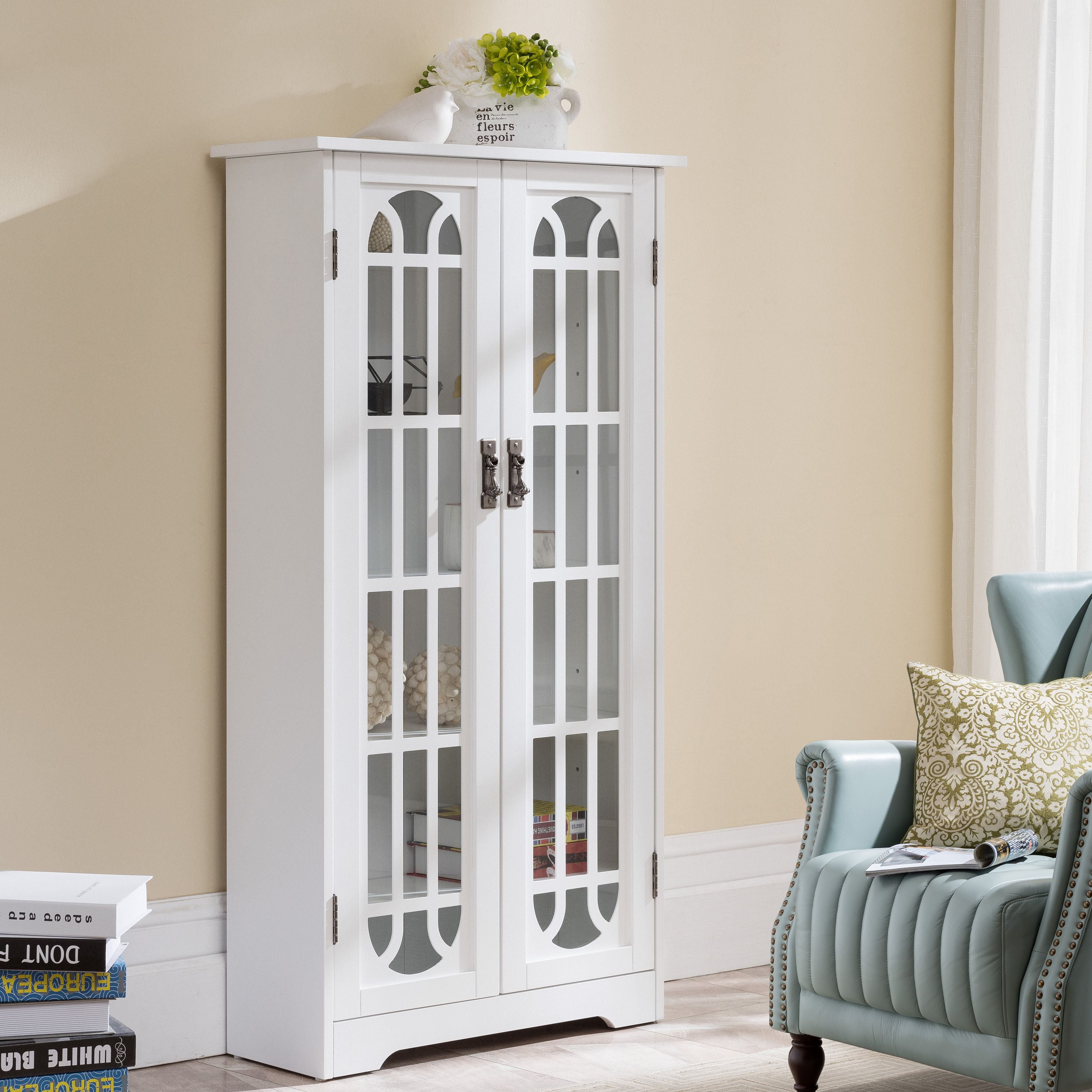Design Considerations for White Floor Cabinets with Glass Doors: White Floor Cabinet With Glass Doors

White floor cabinets with glass doors offer a blend of practicality and aesthetic appeal, capable of transforming any space. The design choices, however, significantly impact the final look and functionality. Careful consideration of style, hardware, and lighting is crucial for achieving a cohesive and visually stunning result.
Cabinet Styles and Materials
The style of your white floor cabinets with glass doors plays a pivotal role in the overall aesthetic. Different door styles create distinct visual effects, influencing the room’s ambiance. The following table summarizes key options:
| Style | Description | Material Options | Suitable Room Types |
|---|---|---|---|
| Framed | Features a visible frame surrounding the glass panel, adding a traditional or rustic touch. | Wood (oak, maple, cherry), MDF, painted wood | Traditional kitchens, formal dining rooms, libraries |
| Frameless | Clean, minimalist design with the glass panel directly inset into the cabinet frame. | MDF, tempered glass, high-gloss paint | Modern kitchens, contemporary living rooms, minimalist bathrooms |
| Frosted Glass | Offers privacy while still allowing light to filter through. Various frost patterns are available. | Tempered glass with frosted film or etched designs | Bathrooms, pantries, kitchens needing some level of concealment |
| Mullioned | Incorporates multiple panes of glass separated by thin mullions, creating a more intricate design. | Wood, metal, or composite mullions with tempered glass | Traditional or eclectic kitchens, formal dining rooms |
Hardware Selection and its Aesthetic Impact, White floor cabinet with glass doors
The choice of cabinet hardware significantly influences the overall aesthetic. Different materials and styles evoke different feelings and suit various design schemes.
White floor cabinet with glass doors – Consider these hardware material options:
- Brushed Nickel: Offers a subtle, modern look that complements both traditional and contemporary styles. Pros: Durable, versatile. Cons: Can show fingerprints.
- Polished Chrome: Provides a sleek, reflective finish, ideal for modern or minimalist designs. Pros: Sleek, easy to clean. Cons: Can look cold or sterile in some settings.
- Black Matte: Creates a sophisticated, bold statement, adding a touch of drama to the space. Pros: Stylish, hides fingerprints. Cons: Can be less versatile than other options.
- Oil-Rubbed Bronze: Offers a warm, aged look, suitable for traditional or rustic settings. Pros: Rich, classic appearance. Cons: Requires more maintenance than other finishes.
Interior Cabinet Lighting Solutions
Proper lighting within the cabinets is crucial for showcasing the items stored inside and preventing shadows. Various lighting options offer different effects.
Consider these lighting solutions:
- LED Strip Lights: Provide even, diffused illumination, ideal for highlighting collections or showcasing delicate items. They offer energy efficiency and a customizable color temperature.
- Spotlights: Offer focused illumination, perfect for highlighting specific items or creating dramatic accents. They can be adjusted to direct light exactly where needed.
- Puck Lights: Small, recessed lights that provide a subtle, ambient glow. They are discreet and suitable for smaller cabinets.
Maintenance and Care for White Floor Cabinets with Glass Doors

Maintaining the pristine look of your white floor cabinets with glass doors requires consistent effort, but the results are well worth it. Regular cleaning and preventative measures will keep your cabinets looking their best for years to come, protecting your investment and enhancing your kitchen’s aesthetic appeal. Neglect, however, can lead to irreversible damage.
Cleaning and Maintaining White Floor Cabinets with Glass Doors
Regular cleaning is key to preventing issues and maintaining the beauty of your cabinets. Here’s a step-by-step guide:
- Dusting: Begin by dusting the cabinet surfaces and glass doors with a soft, dry microfiber cloth. This removes loose dust and debris, preventing scratches during subsequent cleaning steps. Pay close attention to crevices and corners.
- Washing: Mix a mild dish soap solution (a few drops of dish soap in warm water) and gently wipe down the cabinet surfaces with a soft sponge or cloth. Avoid abrasive cleaners that can scratch the finish. For stubborn stains, allow the soap solution to sit for a few minutes before wiping.
- Glass Cleaning: Clean the glass doors separately using a glass cleaner and a lint-free cloth. Spray the cleaner onto the cloth, not directly onto the glass, to avoid streaks. Wipe in a circular motion, then buff dry for a streak-free shine.
- Drying: Thoroughly dry all surfaces with a clean, dry microfiber cloth. Leaving moisture can lead to water spots or damage to the cabinet finish. Pay particular attention to the edges and seams.
- Polishing (Optional): For an extra layer of protection and shine, consider using a furniture polish specifically designed for painted surfaces. Apply sparingly and buff to a high gloss.
Common Issues and Preventative Measures
Understanding common problems and implementing preventative measures will significantly extend the lifespan of your cabinets.
| Problem | Prevention | Solution |
|---|---|---|
| Scratches on Cabinet Surfaces | Use soft cloths and avoid abrasive cleaners. Use protective pads under heavy items. | Minor scratches may be buffed out with a fine-grit polishing compound. Deep scratches may require repainting or professional repair. |
| Discoloration | Avoid direct sunlight exposure. Clean spills immediately. Use coasters under drinks. | Mild discoloration can sometimes be removed with a specialized cleaner for painted surfaces. Severe discoloration may require repainting. |
| Damaged Glass Doors | Handle with care. Avoid impacts. Use protective film if necessary. | Minor chips or cracks might be repairable by a glass specialist. Significant damage usually requires replacement. |
| Loose Hinges or Handles | Regularly check for tightness. Tighten screws periodically. | Tighten loose screws. If the problem persists, consult a professional for repair or replacement. |
